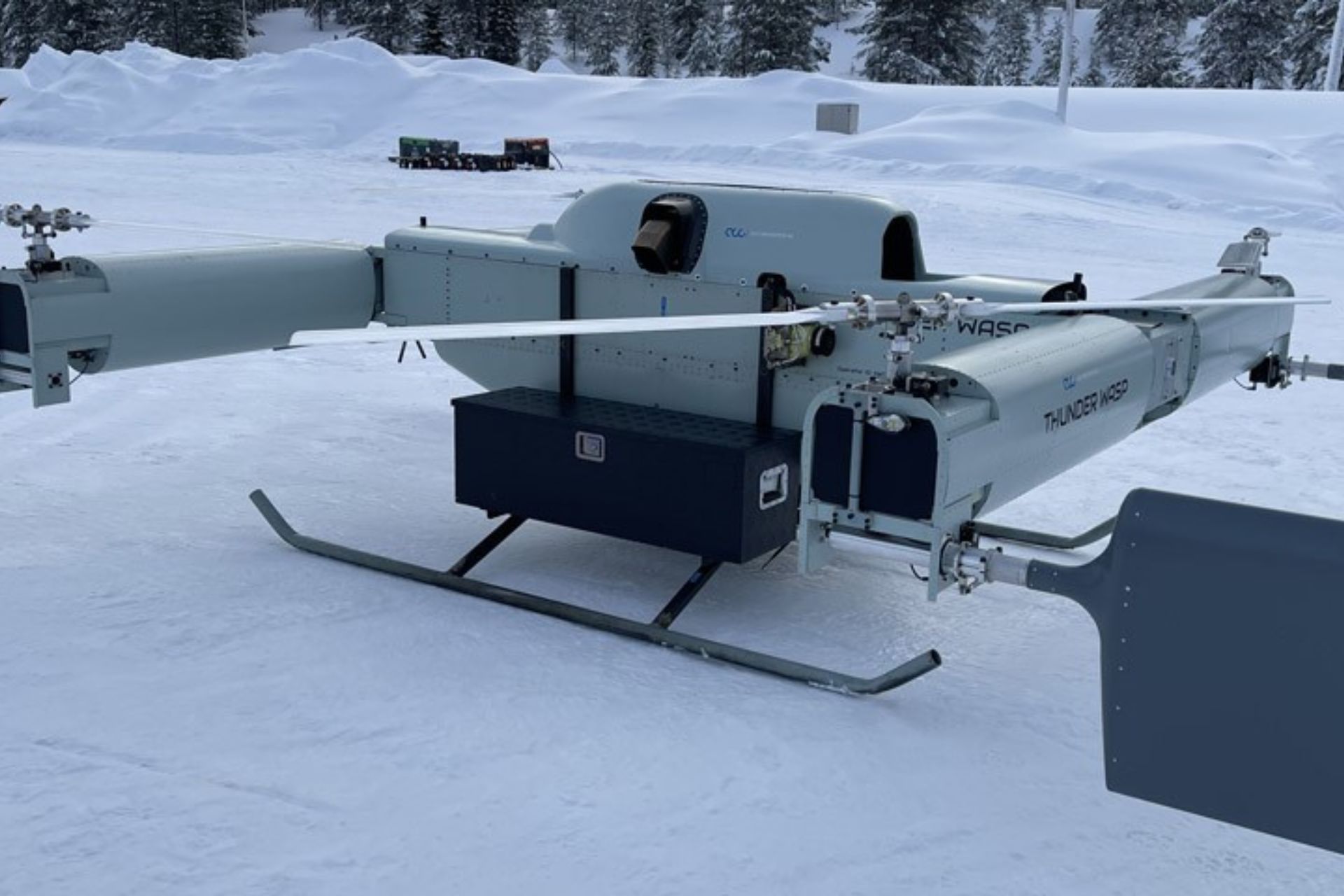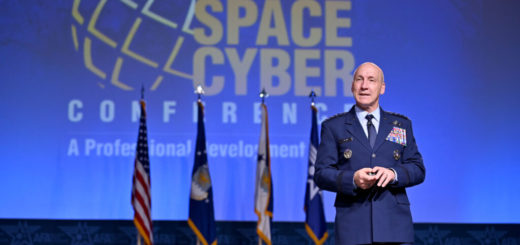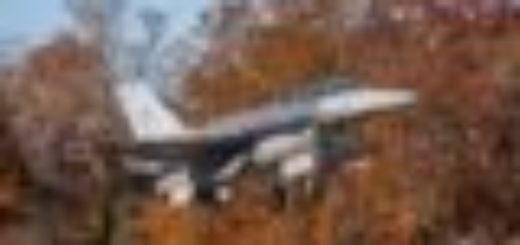Thunder Wasp GT drone militarized by Patria and ACC Innovation to enhance NATO tactical mobility

{loadposition bannertop}
{loadposition sidebarpub}
Finnish defense group Patria and Swedish company ACC Innovation have entered into a cooperation agreement to develop militarized quadcopter drones for a NATO member state. The partnership begins with the militarization of the Thunder Wasp GT, a drone developed by ACC Innovation with a maximum take-off weight of approximately 800 kg. The initiative aims to address the growing need for autonomous aerial mobility and heavy-lift capabilities in modern operational theaters.
Follow Army Recognition on Google News at this link
The Thunder Wasp GT is a VTOL (Vertical Take-Off and Landing) quadcopter drone powered by a PBS TS100 turboshaft engine, capable of carrying up to 390 kg of payload. (Picture source: Patria)
Drawing on its extensive experience in defense research and development, Patria will play a key role in integrating intelligent features into the Thunder Wasp GT platform while ensuring that the system meets military mission requirements. According to Mikko Leino, Executive Vice President of Operations at Patria, the company brings proven expertise in integrating robust capabilities into complex platforms to meet performance objectives under demanding operational conditions.
ACC Innovation, known for its high-performance quadcopter systems, views this cooperation as a strategic opportunity to expand the application of autonomous aerial technologies. Max Drougge, Chief Technology Officer at ACC Innovation AB, stated that the partnership will combine the technical strengths of both companies to develop a system focused on safety, reliability, and mission effectiveness.
The Thunder Wasp GT is a VTOL (Vertical Take-Off and Landing) quadcopter drone powered by a PBS TS100 turboshaft engine, capable of carrying up to 390 kg of payload. With a maximum take-off weight of around 800 kg, it ranks among the world’s largest quadcopters. ACC Innovation has also developed an enhanced version, the Thunder Wasp 2xTS, with a take-off capacity of up to 1,500 kg. The GT model was selected as the Most Viable Product (MVP) by the UK Ministry of Defence as part of the Heavy Lift Challenge program, confirming its operational potential. As part of the agreement with Patria, the drone will be adapted to NATO standards, including the integration of secure communication systems, modular payloads, and configurations tailored for military missions.
Once adapted for military use, the Thunder Wasp GT could provide a new capability for armed forces, particularly in NATO operations, where flexibility, rapid deployment, and autonomous systems are increasingly critical. Both companies share a common approach to technological development tailored to evolving operational environments.
Patria has been working for several years on unmanned systems for military use, with a specific focus on the harsh Arctic environments typical of the Nordic region. Its approach covers the full operational chain, including mission planning, navigation in extreme conditions, payload management, communication assurance, and mission result analysis. These integrated capabilities position Patria as a key partner for the development and deployment of advanced military aerial systems.
This announcement reflects a broader strategic trend among NATO member states to strengthen technological autonomy in response to emerging security challenges. The deployment of heavy drones capable of transporting substantial loads introduces new possibilities in tactical logistics, automated resupply, medical evacuation, and support to special operations in contested zones. The development of such platforms also illustrates the growing European investment in disruptive technologies aimed at reducing reliance on non-European defense equipment.
By integrating the Thunder Wasp GT into a military standards framework and assigning it to specific operational roles, this collaboration between Patria and ACC Innovation offers a tangible response to the evolving mobility and agility needs of modern armed forces. It may also pave the way for future initiatives focused on the standardization and interoperability of heavy drones within NATO, supporting joint efforts to address the technological demands of future conflicts.

{loadposition bannertop}
{loadposition sidebarpub}
Finnish defense group Patria and Swedish company ACC Innovation have entered into a cooperation agreement to develop militarized quadcopter drones for a NATO member state. The partnership begins with the militarization of the Thunder Wasp GT, a drone developed by ACC Innovation with a maximum take-off weight of approximately 800 kg. The initiative aims to address the growing need for autonomous aerial mobility and heavy-lift capabilities in modern operational theaters.
The Thunder Wasp GT is a VTOL (Vertical Take-Off and Landing) quadcopter drone powered by a PBS TS100 turboshaft engine, capable of carrying up to 390 kg of payload. (Picture source: Patria)
Drawing on its extensive experience in defense research and development, Patria will play a key role in integrating intelligent features into the Thunder Wasp GT platform while ensuring that the system meets military mission requirements. According to Mikko Leino, Executive Vice President of Operations at Patria, the company brings proven expertise in integrating robust capabilities into complex platforms to meet performance objectives under demanding operational conditions.
ACC Innovation, known for its high-performance quadcopter systems, views this cooperation as a strategic opportunity to expand the application of autonomous aerial technologies. Max Drougge, Chief Technology Officer at ACC Innovation AB, stated that the partnership will combine the technical strengths of both companies to develop a system focused on safety, reliability, and mission effectiveness.
The Thunder Wasp GT is a VTOL (Vertical Take-Off and Landing) quadcopter drone powered by a PBS TS100 turboshaft engine, capable of carrying up to 390 kg of payload. With a maximum take-off weight of around 800 kg, it ranks among the world’s largest quadcopters. ACC Innovation has also developed an enhanced version, the Thunder Wasp 2xTS, with a take-off capacity of up to 1,500 kg. The GT model was selected as the Most Viable Product (MVP) by the UK Ministry of Defence as part of the Heavy Lift Challenge program, confirming its operational potential. As part of the agreement with Patria, the drone will be adapted to NATO standards, including the integration of secure communication systems, modular payloads, and configurations tailored for military missions.
Once adapted for military use, the Thunder Wasp GT could provide a new capability for armed forces, particularly in NATO operations, where flexibility, rapid deployment, and autonomous systems are increasingly critical. Both companies share a common approach to technological development tailored to evolving operational environments.
Patria has been working for several years on unmanned systems for military use, with a specific focus on the harsh Arctic environments typical of the Nordic region. Its approach covers the full operational chain, including mission planning, navigation in extreme conditions, payload management, communication assurance, and mission result analysis. These integrated capabilities position Patria as a key partner for the development and deployment of advanced military aerial systems.
This announcement reflects a broader strategic trend among NATO member states to strengthen technological autonomy in response to emerging security challenges. The deployment of heavy drones capable of transporting substantial loads introduces new possibilities in tactical logistics, automated resupply, medical evacuation, and support to special operations in contested zones. The development of such platforms also illustrates the growing European investment in disruptive technologies aimed at reducing reliance on non-European defense equipment.
By integrating the Thunder Wasp GT into a military standards framework and assigning it to specific operational roles, this collaboration between Patria and ACC Innovation offers a tangible response to the evolving mobility and agility needs of modern armed forces. It may also pave the way for future initiatives focused on the standardization and interoperability of heavy drones within NATO, supporting joint efforts to address the technological demands of future conflicts.






